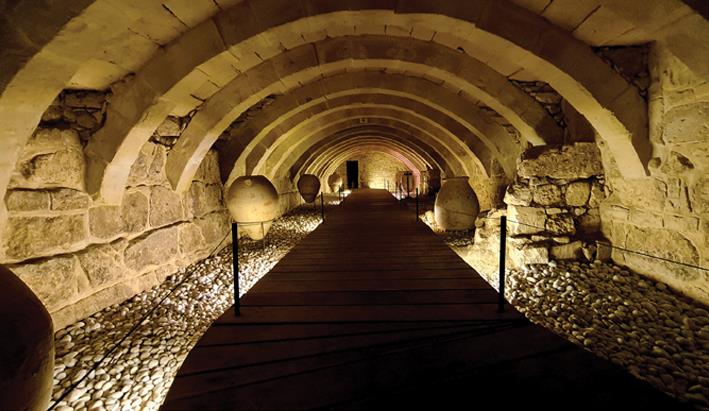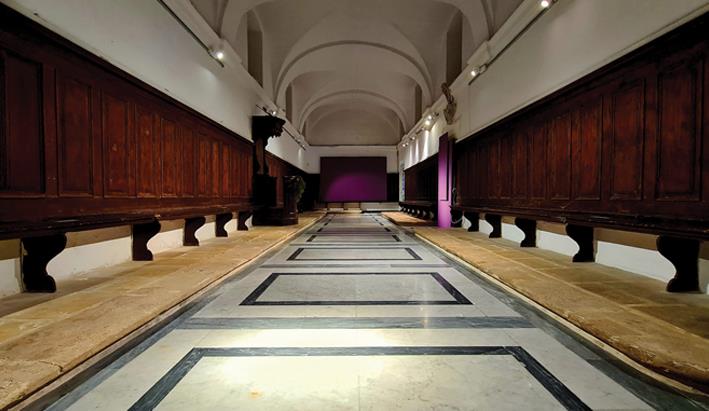As the artistic director of the APS Mdina Biennale, why did you choose the theme 'Mediterranean Goddesses' for the fourth edition of this project?
It is vitally important that every edition has its own specific theme. This next edition's theme was discussed with Dr Nikki Petroni and the Mdina Cathedral Museum curator, Mgr Dr Edgar Vella. After several meetings and discussions, Dun Edgar proposed the title 'Mediterranean Goddesses' which immediately provoked a positive reaction from me since it tallies with the Mediterranean policy I am attempting to instill. My belief is that the Mediterranean region can be studied as a cultural hub.
Dun Edgar recalled my works produced some years ago which sought to symbiotically integrate Maltese prehistoric representations of the One Goddess with our Christian historical development, particularly that of the Byzantine icon. It is a beautiful theme that really coincides with my own aesthetic philosophy as artistic director.

Why is this year's edition focused on the Mediterranean region?
Without imposing the Mediterranean identity on each edition, I personally think that this consideration is inextricable from my academic and artistic aura. Therefore, it cannot really be avoided. Whatever I do resonates with my own Mediterranean worldview.
All cultures are deeply important and radically intertwined especially in the intercultural approach. However, we must acknowledge our tangible proximity with the Mediterranean. It is not really a matter of choice.
Unfortunately, or fortunately, we were geographically born in the centre of the Mediterranean, so we must partake in this Mediterranean culture. Despite its debatable status, I still believe in a Mediterranean culture and identity. Due to the historical schisms that occurred in this region, it is understandable that the Mediterranean identity has been fragmented. Even my approach to the Mediterranean is fractured as it reflects this splintered reality.
The Mdina Biennale forms part of this ongoing process which links it with our Changing Gear project which specifically relates to this Mediterranean Modern art question. Individual Mediterranean countries and cultural movements have been studied but not in a holistic manner which encapsulates the entire Mediterranean region as a recognised cultural hub.
I am very happy that within the University of Malta I was able, together with my colleagues and students, to start implementing this idea. My thanks go to Dr Nikki Petroni, Matthew Shirfield, Kylie Aquilina, Francesco Bellia, Justin Fenech, Michaele Zammit, Alexandra Mara Camilleri, Sara Mitrovic, Anna Scerri, Brooke Vella, Alaine Baker, Peter Aquilina, Liam Agius, Crystal Azzopardi, Miguel Ellul, and other team members who have helped me in this endeavor.
There is a strong academic, artistic, political, economic, and cultural affinity between North Africa and South Europe. So, while the project delves into this question from an artistic research perspective, the Mdina Biennale will be tackling the same question from the point of view of artistic praxis.
The Mediterranean is a mosaic of different elements. Previously, academics were only studying the individual tesserae on their own, but now Changing Gear is trying to propose a method that analyses this mosaic as one whole complete artwork, although talking about the Mediterranean as a holistic unit is still debatable.

Given our current secular culture and almost cynical approach to faith, why is the current edition of the Mdina Biennale focusing on the concept of the Goddess?
Religion has no monopoly over Goddesses or Gods, even for a non-believer. The theme of God or Goddesses is deeply intriguing because it exists whether a non-believer accepts it or not.
Regardless of whether one is approaching the question from a theological, mythological, literary, or even historical, perspective, one cannot deny the existence of these concepts. Such concepts deal with humankind as a 'species-being' category.
Without entering anthropological and philosophical debates, the fact that humanity has multitudes of mythological narratives independently from the sources, whether Aboriginal, Chinese, European or North African, reveals that humankind needs mythology, religion, and the corresponding theology.
I distinguish mythology from religion despite the strong affinity between them. What one may call ancient Greek religion is termed as mythology. The term myth is important because I believe that only myth, according to my own definition of myth, can give us truth.
Myth and Religion, in different manners, mould identity and authenticity.
This year the refectory and the subterranean vaults were chosen as exhibition spaces. What is the artistic reason for this decision?
For every edition we choose spaces that would differ from those exploited in the previous years.
In the first edition we used several spaces across Mdina. In the second edition we chose different spaces within the Mdina Cathedral Museum, and in the third edition the exhibition was once again held in the museum but with a slight revision from the 2017 edition.
After many discussions with Dr Petroni, we decided to contain the exhibition within the refectory and the subterranean vaults to avoid any artistic dissonances, much welcomed in previous editions, with the permanent exhibits at the museum.
The proposals we have received would not make sense if they were juxtaposed in any other way. In the past, we took the curatorial approach of juxtaposing the contemporary works with the permanent exhibition. This created a fascinating dialoguing ambiance. In such cases, artists also studied the space to engage in a visual dialectic with the museum's permanent exhibition. This time we opted for a different approach. As always, I provoke challenges to myself.
It has been decided that this edition would have its own designated space, mirroring the themes which change and evolve with every edition, thereby creating a beautiful sense of flow and evolution.
In the past editions of the Mdina Biennale, the artistic themes ventured into spirituality, faith, the Mediterranean, and the environment. Why are these themes relevant to our contemporary age and to the development of art?
I cannot pretend that I can respond to this important question. I find that I cannot differentiate art from philosophy, and I cannot separate art from theology even though I am a non-believer, continuously in search of meaning and spirituality. Human values are interconnected and integrally linked even if they are by nature fragmented.
You mentioned the environment. If one looks at the catalogue of the 2020 edition which focused on the ongoing environmental crisis, it will become evident that climate change and mythology cannot be separated. In fact, the second half of the title was 'Regaining a Paradise Lost,' integrating Milton's and Dante's ideas into the contemporary artistic reconsiderations at the heart of the Mdina Biennale. These seemingly disconnected spheres are in fact unified. A surgeon has to secede the body's members to help make sense of it and to operate, but nonetheless the human body, mind, and soul remain as one. Despite the practical need to isolate and provoke meaning, it is important to acknowledge the fact that these are all elements of oneness.
This year the Mdina Biennale will be paying homage to Giorgio Preca. Why has this artist been chosen? What is his relation to the theme 'Mediterranean Goddesses'?
Despite my great belief in oneness, when it comes to discussing humankind's 'species-being' development, I simultaneously believe in a certain element of dissonance. Dissonance, like an electric shock, awakens the spectator. Therefore, even though there might not be any direct link, although debatably there is, your question is sustaining the approach.
It is very difficult to impose a 'Mediterranean Goddesses' theme onto Giorgio Preca's works. Therefore, the introduction of his works would intentionally create an element of dissonance.
Moreover, it is a quasi-dogmatic principle in the Mdina Biennale that every edition must be linked with the work of former generations of Maltese masters. In past editions, homage was paid to Frank Portelli, Josef Kalleya, Carmelo Mangion, Esprit Barthet, Antoine Camilleri, and Toni Pace. This year, the Mdina Biennale will showcase works by Giorgio Preca.
It is my sincerest desire to provoke a discussion on 'why Preca was chosen.' The start of the discussion would be to ask, 'why not?' In addition to being a master of European painting, Preca went back to what is termed in artistic philosophy as the Bakhtinian 'skaz' which means 'going back to childhood.'
From an individual point of view, Preca went back to child drawing, but this must also be seen holistically as a 'species-being' going back to humankind's 'childhood.' In my opinion, Preca is calling forth Maltese art to participate in this return. Formally, it may have nothing to do directly with 'Mediterranean Goddesses' as a theme, but it is dialectically related with Malta's going back to its primordial prehistoric identity.
Therefore, the answer is multi-levelled.
There is firstly the question of dissonance, but within the dissonance itself there are harmonious links which can be found. The Mdina Biennale is not attempting to have all the answers for all the questions. Preca chose this visual approach and infused a deep level of love towards his home country. Although bordering on the comic, his 'skaz' is not a cynical approach towards Malta. In his works lies embedded a great element of love which still needs to be studied.
The APS Mdina Biennale will run from 13 November to 15 December at the Mdina Cathedral Museum. For more information on the project please visit the website https://www.mdinabiennale.com/.